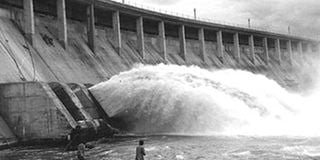Prime
Know Uganda: The Owen Falls Dam at 58

What you need to know:
Jinja is a town with an industrial rich history. It owes its majesty to the fact tha it is the home of the scenic and all important Owen Falls dam
As the colonial government made advances at consolidating its stay in Uganda, the desire to live a comfortable life presented a new challenge to the queen’s emissaries in black Africa.
Besides the need to ease their access to mineral resources and cash crop fields through good roads and later railway, there was urgency to find an alternative source of white energy. Coal, which they used was incessantly becoming costly as it had to be imported from Britain.
After several surveys and consultations, in 1947, the government at Westminster dispatched their engineer, Sir Charles Redvers Westlake who recommended the construction of a hydroelectric dam; just an estimated 4kilometres from the point the river leaves Lake Victoria. The dam was named Owen Falls dam because it was constructed just below [north] and these had been named after Dr. David Owen the then British foreign secretary by Sir Church hill Winston.
Before the construction, it is said the two falls existed. The Ripon Falls and the Owen Falls as the biggest. At the spot there where huge rocks that naturally controlled the flow of water out of the lake, though rapid and violent, it attracted a myth and earlier chiefs in Busoga, like Lubas frequently paid homage.
On completion in 1954, the dam submerged the Ripon falls and supplied electricity to Uganda and western Kenya, also a British colony and a more industrialised one [it is said this was one of the primary reasons for the Dam construction with funding sourced from both colonies].
Later named Nalubale power station, its rating is 180 megawatts (MW).
Originally it was designed for ten turbines rated at 15 MW each (giving a total of 150 MW). The station was refurbished in the 1980s to repair the accumulated wear from a decade of civil disorder. During the repairs, the output power of the generators was increased.
According to Mr Steven Kisubi the UNRA Jinja station engineer says the bridge, running over the dam, is 0.8km, 58 years old but has not out lived its life because of the periodic maintenance and repairs. This bridge which acts as the main connection between the country’s two regions; East and Central ferries an average of 2,000 cars daily, an equivalent of 732, 000 a year.
When the current dam was built, a treaty between Uganda and Egypt was signed to ensure the natural flow of the Nile would not be altered by the dam thus obliging Uganda government to at all times inform or make consultations with their Cairo counterparts every time a major activity is under taken along the River.
With concrete as its major material for construction, it has been found fit to build an alternative bridge as repairs are continuously getting strained due to technological evolution. The new bridge with constitute mainly steel plates as opposed to concrete.
The Dam is under a concession to Eskom, a South African with its region offices below the Dam. According to elders and available records, the Dam was officially opened in 1955 by Queen Elizabeth at a time she had just ascended to the throne following her father’s [King George viii] death. She resided at Amber Court which was the official residence of the Eastern regional provincial commissioner, 650 meters from the Dam.
The only two times, the head of British government has visited her former colony. The Dam is built in such a way that water flows through it as per the electricity demand. Water is let through or blocked by huge metallic spill gate ways which are operated automatically. This helps in fulfilling the National Environmental Management Authority requirement of letting through a certain amount of water at a given time.
Located north of Lake Victoria, all the natural geographical features, and man-made ones by nomenclature, assert our colonial masters presence and influence on the country; Lake Victoria, Ripon falls, Owen falls, Amber court.
Today, Jinja town came to be [then] an industrial town because of the Dam. It has easy access to electric power a major motivation for factories.
Dam history
In 1947, Sir Charles Redvers Westlake (an English engineer) reported to the Colonial Government of Uganda recommending the construction of a hydroelectric dam at Owen Falls near the city of Jinja, which in turn led to the establishment of the Uganda Electricity Board (UEB), with Westlake as its first chairman.
The dam was completed in 1954, submerging Ripon Falls. It supplies electricity to Uganda and parts of neighbouring Kenya and Tanzania. Maintenance and availability of the station declined seriously during the government of Idi Amin.
Before that, water levels on Lake Victoria were moderated by a natural rock dam on the north side of the lake. Rising lake waters would spill over the natural dam into the White Nile, which flowed through Uganda, Sudan, and Egypt before emptying into the Mediterranean Sea.
When water levels dropped too low, flow into the river ceased. When the current dam was built, a treaty between Uganda and Egypt ensured that the natural flow of the Nile would not be altered by the dam..
[email protected]




